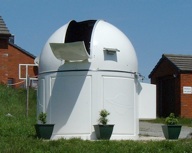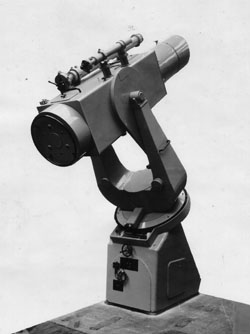A Wide-Field Asteroid Search Project
Current Situation
 The Spaceguard Centre has already developed an affordable (but research grade) robotic telescope system, SNAP, that is optimised for tracking potentially hazardous NEOs that have been detected elsewhere. However, there are limitations. The system has a very narrow field of view, and as such is not suitable for a search programme. To help to fill this capability gap the Spaceguard Centre needs a wide-field surveillance system.
The Spaceguard Centre has already developed an affordable (but research grade) robotic telescope system, SNAP, that is optimised for tracking potentially hazardous NEOs that have been detected elsewhere. However, there are limitations. The system has a very narrow field of view, and as such is not suitable for a search programme. To help to fill this capability gap the Spaceguard Centre needs a wide-field surveillance system.
Project DRAX Objective
The aim of Project DRAX is to install and operate a 24 inch (61 cm) Schmidt Camera (it would be the largest telescope in Wales) at the Spaceguard Centre to conduct a wide field sky survey to detect Near Earth Objects and other transient phenomena.
The 24 / 17” Schmidt Camera
 This instrument was built in 1950 by Grubb-Parsons of Newcastle-upon-Tyne. It is a `Classical Schmidt’ – the simplest and most efficient form of the ingenious wide-field camera invented in 1930 by Bernhard Schmidt of Hamburg Observatory. Light falls on a 61 cm (24-inch) mirror with a spherical reflecting surface. It is reflected to a focus in the centre of the tube and half-way up it, 163 cm (64 inches) from the primary mirror. At the focus a photographic plate 15 cm (6 inches) in diameter, which must be bent to fit a curved surface, records the star images from an area of sky 5 degrees in diameter. (The full Moon is half a degree in diameter.). It is an ideal sky-surveying instrument.
This instrument was built in 1950 by Grubb-Parsons of Newcastle-upon-Tyne. It is a `Classical Schmidt’ – the simplest and most efficient form of the ingenious wide-field camera invented in 1930 by Bernhard Schmidt of Hamburg Observatory. Light falls on a 61 cm (24-inch) mirror with a spherical reflecting surface. It is reflected to a focus in the centre of the tube and half-way up it, 163 cm (64 inches) from the primary mirror. At the focus a photographic plate 15 cm (6 inches) in diameter, which must be bent to fit a curved surface, records the star images from an area of sky 5 degrees in diameter. (The full Moon is half a degree in diameter.). It is an ideal sky-surveying instrument.
The telescope tube is over 4 metres long, and the complete assembly stands more than 4 metres high (with the telescope horizontal). The machinery is immaculate – a testament to British engineering when corners were not cut and excellence was a way of life. Weighing in at 7 ½ tons this is a solid, reliable and totally outstanding instrument.


